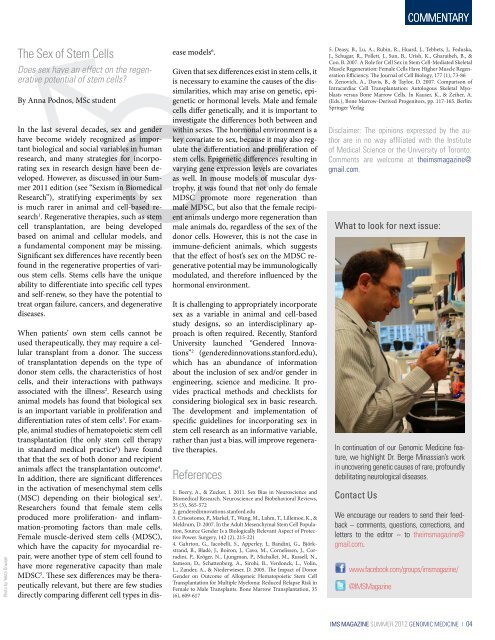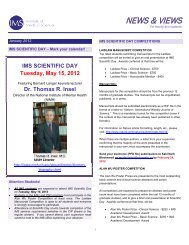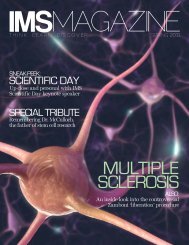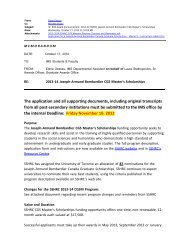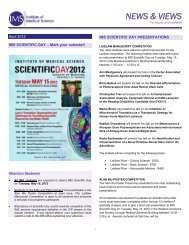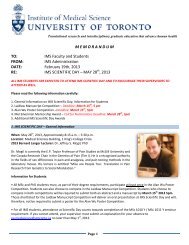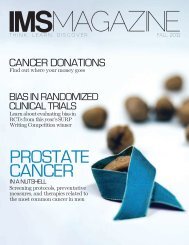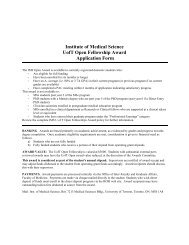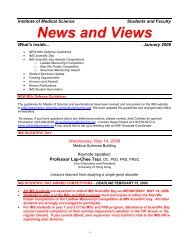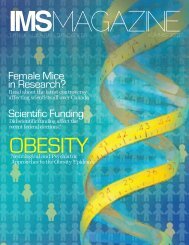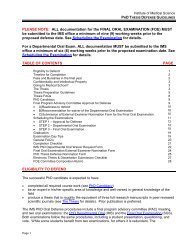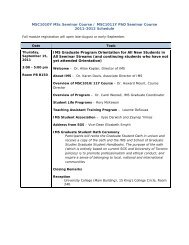IMS Magazine - Summer 2012 edition in PDF format - Institute of ...
IMS Magazine - Summer 2012 edition in PDF format - Institute of ...
IMS Magazine - Summer 2012 edition in PDF format - Institute of ...
You also want an ePaper? Increase the reach of your titles
YUMPU automatically turns print PDFs into web optimized ePapers that Google loves.
COMMENTARY<br />
Photo by Yekta Dowlati<br />
The Sex <strong>of</strong> Stem Cells<br />
Does sex have an effect on the regenerative<br />
potential <strong>of</strong> stem cells?<br />
By Anna Podnos, MSc student<br />
In the last several decades, sex and gender<br />
have become widely recognized as important<br />
biological and social variables <strong>in</strong> human<br />
research, and many strategies for <strong>in</strong>corporat<strong>in</strong>g<br />
sex <strong>in</strong> research design have been developed.<br />
However, as discussed <strong>in</strong> our <strong>Summer</strong><br />
2011 <strong>edition</strong> (see “Sexism <strong>in</strong> Biomedical<br />
Research”), stratify<strong>in</strong>g experiments by sex<br />
is much rarer <strong>in</strong> animal and cell-based research<br />
1 . Regenerative therapies, such as stem<br />
cell transplantation, are be<strong>in</strong>g developed<br />
based on animal and cellular models, and<br />
a fundamental component may be miss<strong>in</strong>g.<br />
Significant sex differences have recently been<br />
found <strong>in</strong> the regenerative properties <strong>of</strong> various<br />
stem cells. Stems cells have the unique<br />
ability to differentiate <strong>in</strong>to specific cell types<br />
and self-renew, so they have the potential to<br />
treat organ failure, cancers, and degenerative<br />
diseases.<br />
When patients’ own stem cells cannot be<br />
used therapeutically, they may require a cellular<br />
transplant from a donor. The success<br />
<strong>of</strong> transplantation depends on the type <strong>of</strong><br />
donor stem cells, the characteristics <strong>of</strong> host<br />
cells, and their <strong>in</strong>teractions with pathways<br />
associated with the illness 2 . Research us<strong>in</strong>g<br />
animal models has found that biological sex<br />
is an important variable <strong>in</strong> proliferation and<br />
differentiation rates <strong>of</strong> stem cells 3 . For example,<br />
animal studies <strong>of</strong> hematopoietic stem cell<br />
transplantation (the only stem cell therapy<br />
<strong>in</strong> standard medical practice 4 ) have found<br />
that that the sex <strong>of</strong> both donor and recipient<br />
animals affect the transplantation outcome 4 .<br />
In addition, there are significant differences<br />
<strong>in</strong> the activation <strong>of</strong> mesenchymal stem cells<br />
(MSC) depend<strong>in</strong>g on their biological sex 3 .<br />
Researchers found that female stem cells<br />
produced more proliferation- and <strong>in</strong>flammation-promot<strong>in</strong>g<br />
factors than male cells.<br />
Female muscle-derived stem cells (MDSC),<br />
which have the capacity for myocardial repair,<br />
were another type <strong>of</strong> stem cell found to<br />
have more regenerative capacity than male<br />
MDSC 5 . These sex differences may be therapeutically<br />
relevant, but there are few studies<br />
directly compar<strong>in</strong>g different cell types <strong>in</strong> dis-<br />
ease models 6 .<br />
Given that sex differences exist <strong>in</strong> stem cells, it<br />
is necessary to exam<strong>in</strong>e the causes <strong>of</strong> the dissimilarities,<br />
which may arise on genetic, epigenetic<br />
or hormonal levels. Male and female<br />
cells differ genetically, and it is important to<br />
<strong>in</strong>vestigate the differences both between and<br />
with<strong>in</strong> sexes. The hormonal environment is a<br />
key covariate to sex, because it may also regulate<br />
the differentiation and proliferation <strong>of</strong><br />
stem cells. Epigenetic differences result<strong>in</strong>g <strong>in</strong><br />
vary<strong>in</strong>g gene expression levels are covariates<br />
as well. In mouse models <strong>of</strong> muscular dystrophy,<br />
it was found that not only do female<br />
MDSC promote more regeneration than<br />
male MDSC, but also that the female recipient<br />
animals undergo more regeneration than<br />
male animals do, regardless <strong>of</strong> the sex <strong>of</strong> the<br />
donor cells. However, this is not the case <strong>in</strong><br />
immune-deficient animals, which suggests<br />
that the effect <strong>of</strong> host’s sex on the MDSC regenerative<br />
potential may be immunologically<br />
modulated, and therefore <strong>in</strong>fluenced by the<br />
hormonal environment.<br />
It is challeng<strong>in</strong>g to appropriately <strong>in</strong>corporate<br />
sex as a variable <strong>in</strong> animal and cell-based<br />
study designs, so an <strong>in</strong>terdiscipl<strong>in</strong>ary approach<br />
is <strong>of</strong>ten required. Recently, Stanford<br />
University launched “Gendered Innovations”<br />
2 (gendered<strong>in</strong>novations.stanford.edu),<br />
which has an abundance <strong>of</strong> <strong>in</strong><strong>format</strong>ion<br />
about the <strong>in</strong>clusion <strong>of</strong> sex and/or gender <strong>in</strong><br />
eng<strong>in</strong>eer<strong>in</strong>g, science and medic<strong>in</strong>e. It provides<br />
practical methods and checklists for<br />
consider<strong>in</strong>g biological sex <strong>in</strong> basic research.<br />
The development and implementation <strong>of</strong><br />
specific guidel<strong>in</strong>es for <strong>in</strong>corporat<strong>in</strong>g sex <strong>in</strong><br />
stem cell research as an <strong>in</strong><strong>format</strong>ive variable,<br />
rather than just a bias, will improve regenerative<br />
therapies.<br />
References<br />
1. Beery, A., & Zucker, I. 2011. Sex Bias <strong>in</strong> Neuroscience and<br />
Biomedical Research. Neuroscience and Biobehavioral Reviews,<br />
35 (3), 565-572<br />
2. gendered<strong>in</strong>novations.stanford.edu<br />
3. Crisostomo, P., Markel, T., Wang, M., Lahm, T., Lillemoe, K., &<br />
Meldrum, D. 2007. In the Adult Mesenchymal Stem Cell Population,<br />
Source Gender Is a Biologically Relevant Aspect <strong>of</strong> Protective<br />
Power. Surgery, 142 (2), 215-221<br />
4. Gahrton, G., Iacobelli, S., Apperley, J., Band<strong>in</strong>i, G., Björkstrand,<br />
B., Bladé, J., Boiron, J., Cavo, M., Cornelissen, J., Corrad<strong>in</strong>i,<br />
P., Kröger, N., Ljungman, P., Michallet, M., Russell, N.,<br />
Samson, D., Schattenberg, A., Sirohi, B., Verdonck, L., Vol<strong>in</strong>,<br />
L., Zander, A., & Niederwieser, D. 2005. The Impact <strong>of</strong> Donor<br />
Gender on Outcome <strong>of</strong> Allogeneic Hematopoietic Stem Cell<br />
Transplantation for Multiple Myeloma: Reduced Relapse Risk <strong>in</strong><br />
Female to Male Transplants. Bone Marrow Transplantation, 35<br />
(6), 609-617<br />
5. Deasy, B., Lu, A., Rub<strong>in</strong>, R., Huard, J., Tebbets, J., Feduska,<br />
J., Schugar, R., Pollett, J., Sun, B., Urish, K., Gharaibeh, B., &<br />
Coo, B. 2007. A Role for Cell Sex <strong>in</strong> Stem Cell-Mediated Skeletal<br />
Muscle Regeneration: Female Cells Have Higher Muscle Regeneration<br />
Efficiency. The Journal <strong>of</strong> Cell Biology, 177 (1), 73-86<br />
6. Zenovich, A., Davis, B., & Taylor, D. 2007. Comparison <strong>of</strong><br />
Intracardiac Cell Transplantation: Autologous Skeletal Myoblasts<br />
versus Bone Marrow Cells. In Kauser, K., & Zeiher, A.<br />
(Eds.), Bone Marrow-Derived Progenitors, pp. 117-165. Berl<strong>in</strong>:<br />
Spr<strong>in</strong>ger Verlag<br />
Disclaimer: The op<strong>in</strong>ions expressed by the author<br />
are <strong>in</strong> no way affiliated with the <strong>Institute</strong><br />
<strong>of</strong> Medical Science or the University <strong>of</strong> Toronto.<br />
Comments are welcome at theimsmagaz<strong>in</strong>e@<br />
gmail.com.<br />
What to look for next issue:<br />
In cont<strong>in</strong>uation <strong>of</strong> our Genomic Medic<strong>in</strong>e feature,<br />
we highlight Dr. Berge M<strong>in</strong>assian’s work<br />
<strong>in</strong> uncover<strong>in</strong>g genetic causes <strong>of</strong> rare, pr<strong>of</strong>oundly<br />
debilitat<strong>in</strong>g neurological diseases.<br />
Contact Us<br />
We encourage our readers to send their feedback<br />
-- comments, questions, corrections, and<br />
letters to the editor -- to theimsmagaz<strong>in</strong>e@<br />
gmail.com.<br />
www.facebook.com/groups/imsmagaz<strong>in</strong>e/<br />
@<strong>IMS</strong><strong>Magaz<strong>in</strong>e</strong><br />
<strong>IMS</strong> MAGAZINE SUMMER <strong>2012</strong> GENOMIC MEDICINE | 04


